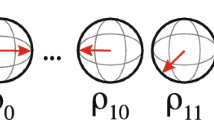Abstract
In this paper we study the problem of a possibility to use quantum observables to describe a possible combination of the order effect with sequential reproducibility for quantum measurements. By the order effect we mean a dependence of probability distributions (of measurement results) on the order of measurements. We consider two types of the sequential reproducibility: adjacent reproducibility (\(A-A\)) (the standard perfect repeatability) and separated reproducibility(\(A-B-A\)). The first one is reproducibility with probability 1 of a result of measurement of some observable A measured twice, one A measurement after the other. The second one, \(A-B-A\), is reproducibility with probability 1 of a result of A measurement when another quantum observable B is measured between two A’s. Heuristically, it is clear that the second type of reproducibility is complementary to the order effect. We show that, surprisingly, this may not be the case. The order effect can coexist with a separated reproducibility as well as adjacent reproducibility for both observables A and B. However, the additional constraint in the form of separated reproducibility of the \(B-A-B\) type makes this coexistence impossible. The problem under consideration was motivated by attempts to apply the quantum formalism outside of physics, especially, in cognitive psychology and psychophysics. However, it is also important for foundations of quantum physics as a part of the problem about the structure of sequential quantum measurements.
Similar content being viewed by others
Notes
Typically in quantum measurement theory one uses the terminology “perfect repeatability” [6]. Since we shall consider two types of reproducibility (repeatability), it is useful to characterize them on the basis of their structure, so “adjacent” matches better with the situation.
For observables with discrete spectra, effects encode the probabilities of the concrete results of observations.
We remark that such instruments need not be of the von Neumann–Lüders type. In general, the quantum operations of are not reduced to projectors.
References
Davies, E., Lewis, J.: An operational approach to quantum probability. Commun. Math. Phys. 17, 239–260 (1970)
Busch, P., Grabowski, M., Lahti, P.: Operational Quantum Physics. Springer, Berlin (1995)
Holevo, A.S.: Statistical Structure of Quantum Theory (Lecture Notes in Physics Monographs). Springer, Heidelberg (2001)
Ozawa, M.: An operational approach to quantum state reduction. Ann. Phys. 259, 121–137 (1997)
Busch, P., Cassinelli, G., Lahti, P.J.: On the quantum theory of sequential measurements. Found. Phys. 20(7), 757–775 (1990)
Buscemi, F., D’ Ariano, G.M., Perinotti, P.: There exist nonorthogonal quantum measurements that are perfectly repeatable. Phys. Rev. Lett. 92, 070403-1–070403-4 (2004)
Jaeger, G.: Quantum Information: An Overview. Springer, Berlin (2007)
Khrennikov, A., Basieva, I., Dzhafarov, E.N., Busemeyer, J.R.: Quantum Models for psychological measurements: an unsolved problem. PLOS One 9, 0110909 (2014)
Khrennikov, A.: Information Dynamics in Cognitive, Psychological, Social, and Anomalous Phenomena. Fundamental Theories of Physics. Kluwer, Dordreht (2004)
Khrennikov, A.: Ubiquitous Quantum Structure: From Psychology to Finances. Springer, Berlin (2010)
Busemeyer, J.R., Bruza, P.D.: Quantum Models of Cognition and Decision. Cambridge Press, Cambridge (2012)
Haven, E., Khrennikov, A.: Quantum Social Science. Cambridge Press, Cambridge (2013)
Haven, E., Khrennikov, A.: Quantum mechanics and violation of the sure-thing principle: the use of probability interference and other concepts. J. Math. Psychol. 53, 378–388 (2009)
Asano, M., Ohya, M., Tanaka, Y., Khrennikov, A., Basieva, I.: On application of Gorini–Kossakowski–Sudarshan–Lindblad equation in cognitive psychology. Open Syst. Inf. Dyn. 18, 55–69 (2011)
Asano, M., Ohya, M., Tanaka, Y., Khrennikov, A., Basieva, I.: Dynamics of entropy in quantum-like model of decision making. J. Theor. Biol. 281, 56–64 (2011)
Dzhafarov, E.N., Kujala, J.V.: Quantum Entanglement and the Issue of Selective Influences in Psychology: An Overview. Lecture Notes in Computer Science, pp. 184–195. Springer, Berlin (2012)
Aerts, D., Sozzo, S., Tapia, J.: A Quantum Model for the Elsberg and Machina Paradoxes. Quantum Interaction. Lecture Notes in Computer Science, pp. 48–59. Springer, Berlin (2012)
Cheon, T., Takahashi, T.: Interference and inequality in quantum decision theory. Phys. Lett. A 375, 100–104 (2010)
Cheon, T., Tsutsui, I.: Classical and quantum contents of solvable game theory on Hilbert space. Phys. Lett. A 348, 147–152 (2006)
D’ Ariano, G.M.: Operational axioms for quantum mechanics. In: Foundations of Probability and Physics-4. G. Adenier, C. Fuchs, and A. Khrennikov (eds.). AIP Conf. Proc. vol. 889, pp. 79–105 (2007)
Chiribella, G., D’Ariano, G.M., Perinotti, P.: Informational Axioms for Quantum Theory. In Foundations of Probability and Physics—6, AIP Conf. Proc. vol. 1424, pp. 270–279 (2012)
D’Ariano, M.: Physics as Information Processing. In Advances in Quantum Theory, AIP Conf. Proc. vol. 1327, pp. 7–16 (2011)
D’Ariano, G.M., Jaeger, G.: Entanglement, Information, and the Interpretation of Quantum Mechanics (The Frontiers Collection). Springer, Berlin (2009)
Sinha, U., Couteau, Ch., Medendorp, Z., Sllner, I., Laflamme, R., Sorkin, R., Weihs, G.: Testing Born’s Rule in Quantum Mechanics with a Triple Slit Experiment. In: Foundations of Probability and Physics-5, L. Accardi, G. Adenier, C.A. Fuchs, G. Jaeger, A. Khrennikov, J.-A. Larsson, S. Stenholm (eds.), American Institute of Physics, vol. 1101, pp. 200–207 (2009)
Khrennikov, A.: Towards Violation of Born’s Rule: Description of a Simple Experiment. In: Advances in Quantum Theory, G. Jaeger, A. Khrennikov, M. Schlosshauer, G. Weihs (eds.), American Institute of Physics, vol. 1327, pp. 387–394 (2011)
Acknowledgments
The authors would like to thank J. Busemeyer and E. Dzhafarov for fruitful discussions and M. D’ Ariano, P. Lahti, W.M. de Muynck, and M. Ozawa for fruitful comments and advices. This project was supported by researcher-fellowship at Mathematical Institute of Linnaeus University (I. Basieva, 2014-15).
Author information
Authors and Affiliations
Corresponding author
Rights and permissions
About this article
Cite this article
Basieva, I., Khrennikov, A. On the Possibility to Combine the Order Effect with Sequential Reproducibility for Quantum Measurements. Found Phys 45, 1379–1393 (2015). https://doi.org/10.1007/s10701-015-9932-3
Received:
Accepted:
Published:
Issue Date:
DOI: https://doi.org/10.1007/s10701-015-9932-3




